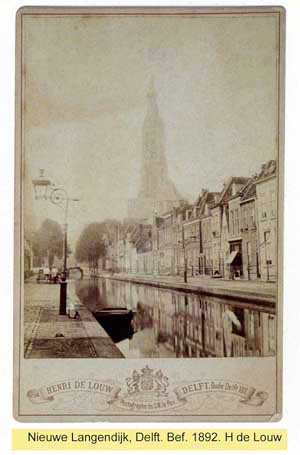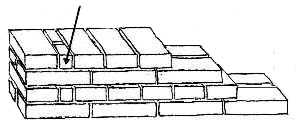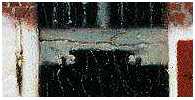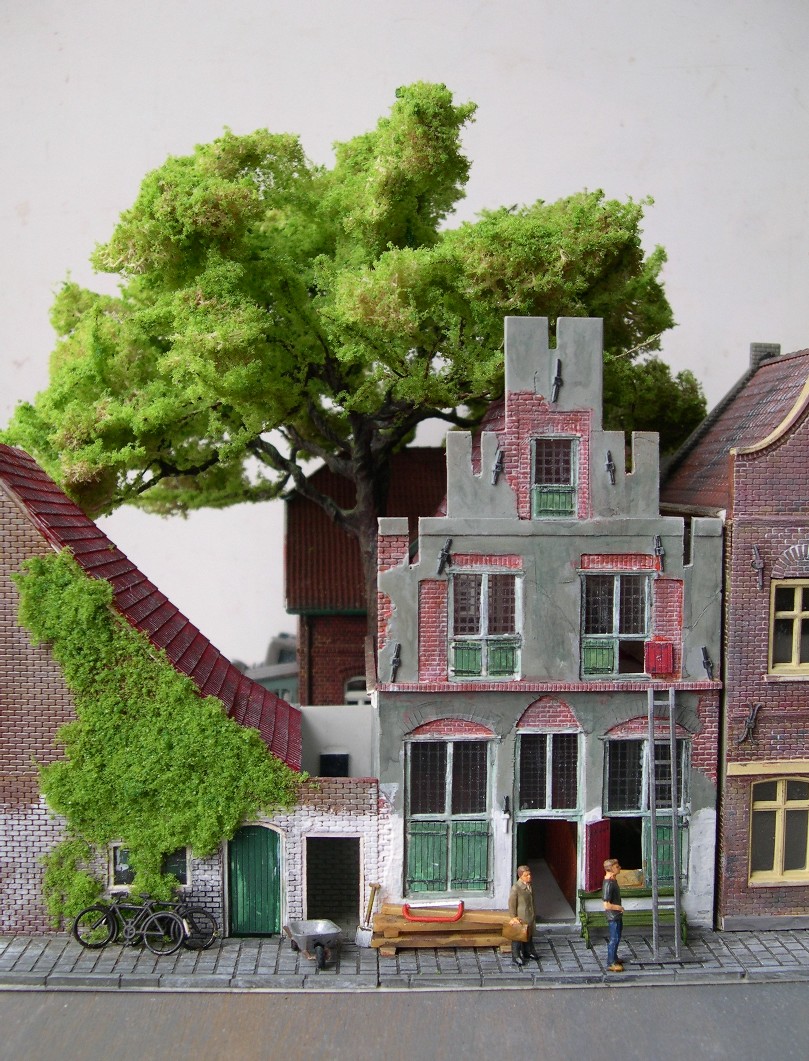
Kees Kaldenbach

====== PRESS RELEASE, DECEMBER 8, 2000 ======
The precise site of the painting 'Little Street' by the Delft artist Johannes Vermeer was located in Delft on Nieuwe Langendijk 22-26. The historic buildings which once stood there were first identified and then completely demolished in 1982. This news has been revealed by Dutch art historian Kees Kaldenbach in the latest issue of the of the Royal Dutch Antiquities Magazine (Bulletin KNOB) which is being presented mid-december 2000.
In 1982 a group of houses on Nieuwe Langendijk 22-26 was the subject of research by a team from the Delft Polytechnic University, assisted by a number of amateur archaeologists. This research occurred shortly before demolition as the houses in question seemed an interesting subject. The group of buildings seemed to date form the sixteenth century or even earlier. One structure in this group, located in the back of these houses, was an uncommonly large building which was out of alignment in relationship to houses along the street.
In the course of this research Wim Weve, active in 1982 as an assistant in the Architecture department of the Delft Polytechnic, realized that the houses on this location were similar to those depicted by Vermeer to such a degree that identification was possible. His "Provisional Report" was published on February 14, 1982, before actual demolition had begun. As his findings had been reported as a private individual and as his report was only distributed in limited circles, his written and oral warnings were ignored by the real estate owner, by the City Magistrates and by the National Bureau of Monuments (Rijksdienst voor de Monumentenzorg). A permit for demolition had already been granted to make space for the building of an old age home on the site. At the time Weve's remarks were also considered "too vague" and unsupported by solid research evidence.
Initially this research on Nieuwe Langendijk 22-26 was architectural-historic in nature, but after the building had disappeared it became purely archeological later on in June and July. Carried out by a team which was supervised by student assistant Claes-Joris van Haaften, research lasted until August 1982. Results were presented by Van Haaften in 1987 when his three volume book which was published by Delft University Press. The extremely detailed research results served as a handbook for students of architectural restoration. The total body of evidence led Van Haaften to support the initial identification as the houses painted by Vermeer. However, Weve's and Van Haaften's publications remained largely unread by historians and art historians and thus remained virtually unknown.
Vermeer specialist and art historian Drs. Kees Kaldenbach, who has recently published the exact dating of the scene in Vermeer's "View of Delft " to a precision of half a month, has done further research on the "Little Street" based on the data provided by Weve and Van Haaften. He communicated with Professor Dr. Ir. C.L. Temminck Groll, emeritus professor of Architectural Restoration at Delft Polytechnic, and well as with both Weve and Van Haaften. The latter two are both currently working as architectural historians in the Dutch towns of Delft and Groningen. In his cover article in Bulletin KNOB Kaldenbach presents all relevant data, and combines and weighs all indications. He lists a total of 14 arguments to support the identification, including:
- the dating of these houses spared during the Great Fire of 1536 which ravaged 4/5 of Delft;
- the height and width, plan, elevation and other architectural characteristics of the houses on Oude Langendijk 22-26;
- the scrubbing gutter, only visible on Vermeer's painting, which proves its location on a canal;
- the distance between painter and subject;
- the play of light within and outside the building nr. 26 (which is the house on the right hand side on Vermeer's painting).
In the conclusion to his article Kaldenbach writes:
"Taken individually, each of the arguments presented above would be inconclusive in identifying the architecture of Nieuwe Langendijk 22-26 as that shown by Vermeer. However, considering the body of indications it has now become almost certain that Weve's tentative conclusions and Van Haaften's solid body of data concerning the location for The Little Street are indeed valid. Their studies enables us to broaden our understanding and appreciation of Vermeer's painting. Cumulatively these concrete indications yield a tapestry of evidence which scarcely contains any margin of error."
======= END OF PRESS STATEMENT ====
I am afraid that English readers are in a bit of a disadvantage here for the moment . The article which is presented in full in the Dutch text on this site can only be presented in a curtailed fashion now, as it still awaits publication in an English language magazine.
The Dutch article starts like this (in an English translation):
At first glance, The Little Street painted by Johannes Vermeer (1632-1675) appears to be an appealing yet unassuming and simple painting. We see an attractive painting of a street with some ancient houses. Compared to The View of Delft (ca. 1661, Mauritshuis, The Hague), precious little has been written about the The Little Street. This "wonderful and modest painting which succeeds in evoking such a wide range of emotions..." and "sings the beauty of everyday life..." seems to defy meaningful description. Yet the longer one looks at it the more interesting it becomes, both in terms of its seemingly documentary representation of late medieval architecture and as a work of art in its own right, as carefully crafted layers of paint on canvas. This article focuses on the painting's documentary qualities and discusses the question whether the Delft location has indeed been pinpointed in 1982. At the end of this article a balance will be presented.
And it ends with this comparison between painting and actual buildings.
Comparison between the painting and the actual site.
V. According to architectural historians, Vermeer shows a house with a brick facade on the right hand side which dates from the second half of the fifteenth Century or the beginning of the sixteenth Century (c.1450-1525). The door being in the middle.
D. Nieuwe Langendijk 26 is situated just within the area spared by the Great Fire of 1536. The architectural history of building nr. 26 dates back to the fourteenth century (with respect to foundations and woorden walls); a brick facade was added in the 2nd half of the fifteenth century. The facade had a door in the middle.
V. Vermeer shows a house which is 28 bricks wide, which are all painted red.
D. Individual bricks in the lower foundation of the facade of nr. 26 have a width of 22 cm. In Vermeer we count 28 bricks each of 22 cm. + 1 1/2 cm. join = a total of 6.58 meter. This is broadly equal to the actual width of Nieuwe Langendijk nr. 26, which is 6,83 meter. Weve noted a basement filled with rubble, amongst which are bricks painted red, having a join painted in white. Part of the bricks were of standard oblong size, others had a profile for use in a corner of a door, and still others for an arch opening.
V. Vermeer shows an exceptionally high room on the ground floor. Given the other measurements this room must be about 4 meters high.
D. Building nr. 26 had such a room. The floor planks of the first floor were ca. 4 meters above the street level during the seventeenth century. The actual height of the ground floor room was still ca. 4 meter, as the upstairs floor had a thickness of only one plank.

V. Vermeer shows a wall with a particular technique of masonry, called klezor and a specific pattern of cracks in the masonry. He paints a house which must have had a wooden framework, to which was added a thin brick facade.
D. Building nr. 26 had such a wooden skeleton which dated from around 1450. On the matter of the system of cracks which had developed around 1658 we have no other documentation than that of Vermeer, but restoration specialists do read a coherent system of stress related cracks which is presented in a documentary fashion in a very convincing way. Vermeer as a lay man could not have invented such a system of cracks.

V. Vermeer shows an arched door opening.The bricks in Vermeer's painting are all rectangular except for those which form the edge and arch of the door opening.
D. The large arch enveloping the doorway was built out of straight bricks and profile bricks which defined the edge towards the street. A basement was dug out in the seventeenth century. The position of this basement was below the right hand room of nr. 26. When the facade was demolished in the nineteenth century, these bricks were used to fill in that basement. The bricks which were excavated from there were painted on the outside face with ochre and the joints were painted white. Some bricks were straight, other had a 3/4 profile and some of these latter were tapered to fit into an arch.
V. On the far left hand side Vermeer seems to paint the front of another house, but when studying the roof structure it has to be a lean-to side room.A twisted angle in the roof structure is visible in Vermeer's painting.
D. When analyzing the structure and beams of the wooden roof of Nieuwe Langendijk 22 in 1982, Weve found evidence that there had once been an annex attached to the east side of this building. This very twist triggered Weve's train of thought and led him to connect the building with Vermeer's The Little Street.
V. When looking at the Vermeer paintting it is difficult to imagine a floor plan of the group of buildings.
D. The position of the various buildings in the painting are quite unusual given the layout of that section of Delft which escaped the fire of 1536. As can be seen, for example, in the floor plan immediately behind the house on the left Vermeer depicts a house (on this picture in blue) whose ground plan shifts somewhat towards the right. On the exact map of the city dating 1832, a similar layout of buildings can be seen which is not found anywhere else within the area left untouched by the fire.
V. At the very left hand side Vermeer shows not a main part of a house but the front of an annex or side room of a house. The main house is not shown. On the yard behind nr 22. Vermeer shows a wide building which has shifted somewhat towards the right. This building which had no interior dividing walls is of the 'hall building' type. Given this identification and documentation Vermeer has depicted its roof in a diminished fashion.
D. Student Wim Weve who was part of the research team in 1982 discovered the beginnings of a downward angle in the lower roof structure of nr. 22. This downward angle formed the beginning of the roof of the annex which was shown by Vermeer in nr. 22. The floor plans of nrs. 22 t/m 26 speak for themselves in this respect.
This structure in a shifted alignment in the back yard is also visible on the map called Kadastrale Minuut (1832) ; the fact that it is out of alignment is quite exceptional in Delft architecture.
Building nr. 24 which was built later on, ca. 1830, had to make use of several pieces of real estate, being the annex or side room of nr. 22, the little alley of nr. 22 and the alley and yard next to nr. 26.
V. Given the various architectural details Vermeer must have painted a number of buildings within the eastern part of Delft which was not devatated by the Great Fire.
D. Nr. 26, measuring no less than 6,83 meter, was an uncommonly wide house within this eastern part of town. It being situated on a canal (see item 7), and the uncommon shift in the alignment of the large house behind nr 22, and the downward angle in the roof structure of nr. 22, and the onetime existence of alleyways must have been exceptional indeed. The elevation drawing by Van Haaften shows that a number of lines in the original architecture represent a precise fit in comparison to Vermeer's painting.
V. Vermeer sepicts a scrubbing gutter which continues its way across the street and thus ends up in a canal.
D. Nieuwe Langendijk nrs. 22 t/m 26 were situated along a canal which was filled in in 1899.
V. Vermeer depicts a chimney at the very top on the right hand side.
D. The kitchen of nr. 26 had a large fire place with a chimney on the right hand side.
V. Vermeer depicts a courtyard with a system of alleyways between these houses.
D. Up to the year 1830 we know nothing of this layout, as we lack a detailed topographical map. But the yard area was certainly unbuilt - which is attested by the existence of a large three-part window in the side wall of nr. 26, allowing daylight into the kitchen and the first floor. Thus it would have been highly unlikely of there were no alleyways over there.
V. All the way in the back Vermeer depticts houses with roofs in in a straight angle with the street which must run in the back.
D. The map called Kaart Figuratief (edition 1702) shows architecture with roofs parallel to the street in the back (which is St. Ursels Straet - present day Trompetstraat) This street runs parallel to Nieuwe Langendyck. However, the Kaart Figuratief is not precise and may be only taken as an indication, but not as proof of the orientation of roofs. The engraver depicted less individual houses within a given stretch than originally were there.
V. Vermeer depicts quite a large house on the third plan.
D. Given the expected height of the architecture at St. Ursuls/Trompetstraat this building has been depicted too high. This may be an adaption due to compositional needs.
V. It is very likely Vermeer depicts a distance between the viewpoint and the houses of some 17,5 to 20 meter at a height of circa 2,5 meter. See Houbolt, 1923 calculation.
D. At that point, across the canal on the other side stood a house on Nieuwe Langendijk. Canal quays and water had a total width of ca. 20 meter.Vermeer will have made preparatory sketches from the first floor of the house straight opposite. The actual paint work was carried out within his studio.
V. Vermeer depincts a faint light shining within the house on the right. This cannot be seen on a reproduction, but is noticeable on the original.
D. House nr. 26 had large windowa at the front and the very back, but also a side window. This was a large three-piece window allowing light to enter the kitchen (the hearth) and the upstairs floor. This window proves the existence of an unbuilt area on the former site of nr. 24.
V. Vermeer depicts the houses in the full shade of clouds. The play of light ans shade is evident near the benches in front of the house. All the way on top Vermeer shows cumulus clouds, which are lit by the sun shining from the left side towards the front. Thus the painting presents a view from the south, looking north.
D. The location Nieuwe Langendijk 22-26 fits this bill. There is morning light. If it is summertime it could even be early morning light. Vermeer presents early morning light on the View of Delft as well.
Taken individually, each of the arguments presented above would be inconclusive in identifying the architecture of Nieuwe Langendijk 22-26 as that shown by Vermeer. However, considering this body of indications it has now become almost certain that Weve's tentative conclusions and Van Haaften's solid body of data concerning the location for The Little Street are indeed valid. Their studies enables us to broaden our understanding and appreciation of this Vermeer painting. Cumulatively these concrete indications yield a tapestry of evidence which scarcely contains any margin of error.
Research by Claes Joris van Haaften and the drawings presented by him and his colleagues form an exciting and convincing argument. It helps us to upgrade the way in which we see, understand and value Vermeer's painting. Their research should be properly acknowledged.
The other side of the medal is that Vermeer monuments have become exceedingly scarce in Delft in the course of the last century. The city gates and walls on Vermeer's The View of Delft were demolished in the nineteenth century. Vermeer's homes were demolished, from Mechelen on Market square to the house on Oude Langendijk, stretching all the way into Molenpoort (now Jozefstraat) in which he painted most of his masterworks. Only his birth house, now an unmarked shoe store, still stands on Voldersgracht.
This is a painful loss. With hindsight we must conclude that as recently as 1982 the city fathers of Delft allowed the demolition of its last potentially great Vermeer monument.
In this essay a detailed description of a townscape painting by Vermeer has been presented. Ample indications support of the identification of the exact location of The Little Street that Weve and Van Haaften identified in 1982. My analysis supports and amplifies their hitherto overlooked findings. Until now, this painting has been seen as an attractive view of a seventeenth-century street. Our knowledge that The Little Street represents actual buildings on a Delft canal helps to deepen our understanding and appreciation of this seemingly unassuming painting.
Email me at kalden@xs4all.nl
Text translated from the Dutch as published in Bulletin KNOB, November-December 2000.
Text copyright drs Kees Kaldenbach, 2000. Launched 8 December 2000. Last update April 21, 2007.
Art histoy information trickles down slowly. In 2001 the Rijksmuseum published the book Netherlandish Art 1600-1700. The text on The Little Street (p. 204) contains a text written by Guido Jansen: "...there is no reason to expect Vermeer's Little Street to be topographically accurate. That is why no one has yet come up with a convincing identification of the houses."
Postscript 2 .

This reconstruction was made by Thonis van der Weel. It shows an imaginary situation in about 1980 in removing the plaster from the facede. I wish it had happened then! Explanation in Dutch on his web site.